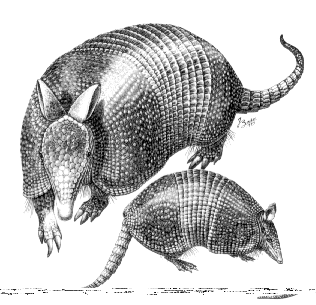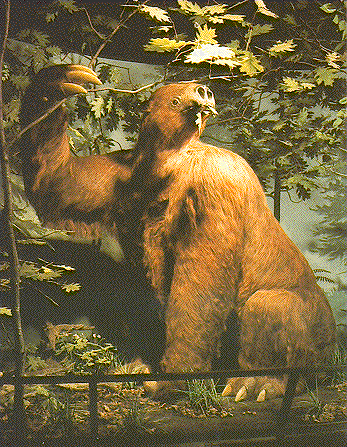Extinct species in North America you never knew existed: large armadillos, giant ground sloths, camels, horses, giant beaver, and so many more...
The beautiful armadillo (scientific name Dasypus bellus) was a larger cousin of the modern nine-banded armadillo (scientific name Dasypus novemcinctus) found throughout the southeastern U.S. The drawing above shows an extinct beautiful armadillo in the background with a modern nine-banded armadillo in the foreground.
The body of the beautiful armadillo was covered with armor composed of thousands of bony scutes. These were probably very effective in protecting the slow armadillo from predators.
In the midwestern U.S. the beautiful armadillo has been found at sites from Indiana, Iowa, and Missouri (map). Like many other Pleistocene large mammals, it went extinct approximately 11,000 years ago.
Four species of ground sloths inhabited the United States at the end of the last Ice Age. These were Jefferson's ground sloth (Megalonyx jeffersonii), Laurillard's ground sloth (Eremotherium laurillardi), the Shasta ground sloth (Nothrotheriops shastensis), and Harlan's ground sloth (Glossotherium harlani). Of these four only two, Jefferson's and Harlan's ground sloths, are found in the midwestern U.S.
The picture above shows a reconstruction of Jefferson's ground sloth from the University of Iowa Museum of Natural History.
Harlan's ground sloth is reconstructed as looking quite similar to Jefferson's.
Ground sloths were large relatives of the modern two-toed sloths (Choloepus spp.) and three-toed sloths (Bradypus spp.). Unlike modern sloths, which spend most of their time in trees, the ground sloths spent all of their time on the ground. This is fortunate because Jefferson's and Harlan's ground sloth were each about the size of an oxen.
All four species of ground sloth had very large claws. However, all were herbivores. They had relatively small, blunt teeth, which they probably used for browsing on trees and shrubs.
The shape of their hip bones indicates that they could stand up on their hind legs. This would allow them to reach high up into trees for the best leaves and twigs.
All four species of ground sloth became extinct in North America approximately 10,000 years ago. The reason for their extinction is being studied by paleontologists.
Although not common, ground sloths occur in the midwestern U.S. This map shows some of the important ground sloth finds in the region.

